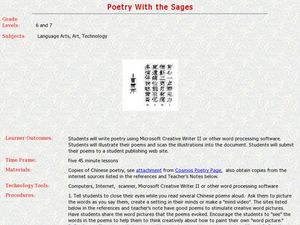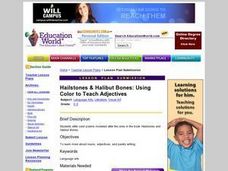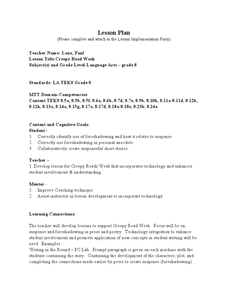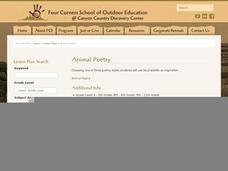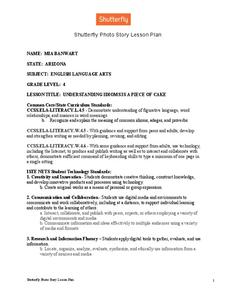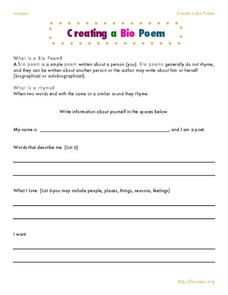Curated OER
Free Verse Poems
The opening slide in this presentation defines free verse poems. The three subsequent slides demonstrate how personal experience can be used as the basis for a free verse poem.
Curated OER
Thanksgiving Acrostic Poems
Students watch streaming video, Holiday Facts and Fun: Thanksgiving, define and discuss acrostic poetry, complete circle map using words associated with Thanksgiving, and create acrostic Thanksgiving poems to be typed in Microsoft Word...
Minnesota Literacy Council
Adult Computer and Employment Skills
Whether you are an experienced computer user or a newcomer to technology, a packet full of computer vocabulary, tips, and guided practice is sure to enhance your technological knowledge. Learners can hone their word processing skills and...
Curated OER
Christmas Tree Shaped Poems
Students think about ways in which they can spread joy during the holiday season. They create poems in the shape of a Christmas tree. Pupils use formatting tools in Microsoft Word to format the text of the poem. Students discuss ways...
Curated OER
Poetry In Motion
Fourth graders read and analyze poetry and examine the process of writing poetry. They read and analyze the poem "From a Railway Carriage" by Robert Louis Stevenson, and answer comprehension questions. They identify the similes,...
Curated OER
Poetry in Motion
High schoolers explore poetry and technology. In this poetry writing activity, students choose a theme and write a pattern poem, then create a related slideshow.
Curated OER
Poetry Through Digital Storytelling
Bring digital storytelling to your language arts class! To begin, learners select their own topic, such as a poem that reflects a life experience they had or a historical figure who interests them. Then they work to create a storyboard...
Curated OER
I Spy Poetry
Explore the components of rhythm and form through a reading of Jean Marzollo's I Spy books. After discussing Marzollo’s format, the class agrees upon a theme for a class book and topics that fit with that theme. Pupils write a poem,...
Curated OER
Making Connections between Robert Frost's Life and His Poetry
Become acquainted with Robert Frost's life in order to allow your class to fully appreciate how his background influenced his poetry. They analyze specified poems in relation to theme, setting and the use of imagery.
Curated OER
Poetry With the Sages
Students write poems and input them into a word processing program. In this poetry lesson, students listen to Chinese poems and draw mental images. Students compose poems and illustrate them. Students share their work.
Curated OER
Splish, Splash Poetry
Students write weather shape poems and sing weather related songs. In this creative writing instructional activity, students read the book, It's Raining, It's Pouring and list weather words they heard in the story. Students use the...
Curated OER
Hailstones & Halibut Bones: Using Color to Teach Adjectives
Students write original color poems based on the poems in the book, "Hailstones and Halibut Bones." They select a color, develop a list of adjectives and characteristics, write a poem, and create a drawing.
Curated OER
Connecting Poetry with Philanthropy
Students use their knowledge of philanthropy and poetic conventions to write original poetry about philanthropic giving. In this philanthropy lesson, students write poetry based on philanthropy using poetic conventions. Students...
Curated OER
Haiku Movies
Students create a movie to illustrate an original haiku poem in this upper-elementary school, Language Arts lesson utilizing technology. The lesson meets state standards for Language Arts and includes a materials list and possible lesson...
Curated OER
Creepy Read Week
Here's a clever technology twist to writing in the round. Participants rotate through a series of computers adding to stories and editing by keystroke and mouse click. "Locked" forms prevent the loss of stories filled with suspense and...
Curated OER
Animal Poetry
Fourth graders write poems that use local wildlife as their inspiration. After a class discussion which produces a list of wildlife that pupils have seen in their town, a review of three types of poetry ensues. They look at how...
Shutterfly
Photo Story Lesson Plan
After reading Loree Leedy's There's a Frog in My Throat: 440 Animal Sayings a Little Bird Told Me, kids create and illustrate their own poems that convey the meaning of an idiom. The poems are then transferred into Shutterfly's Photo...
ReadWriteThink
Alliteration All Around
Discover alliteration found in picture books by Pamela Duncan Edwards. Then, dive into a read aloud of Alligators All Around by Maurice Sendak. This practice sets the stage for budding poets to create their own acrostic poem,...
Nosapo
Creating a Bio Poem
Find out what's special about your pupils with a fun biopoem activity! As they fill out their name, words that describe them, what they love, and what they dream of, learners create an expressive poem about themselves.
Scholastic
Ready to Research Owls
Researching facts about owls can be a hoot for your class. Let them wisely collaborate on this writing project. The resource is the second part of three parts. It is best to use all three lessons in order.
Facebook
Social Media and Sharing
Whether it's cute cat videos or pictures from an epic vacation, scholars love to check out what's happening on social media! But, how much sharing is too much? A lesson from a vast digital citizenship series poses some serious points to...
Curated OER
Acrostic Poems: What's In a Name?
Students find words that begin with the letters in their own names, using a variety of sources including word banks and online dictionaries. They create an acrostic poem. Pupils revise poems as needed, for meaning and conventions. ...
Curated OER
Magnet Poetry
Students engage in a lesson that involves the use of imagery in poetry. They select words from poems that are used for imagery. The words are put onto magnets and then used to create new poems filled with imagery. The hands on connection...
Curated OER
Create a Poem
Students write three simple rhyming poems and read them aloud with rhythm. Students select two adjectives that are opposites and two rhyming verbs to create rhyming lines of the same length with an adjective-noun-verb pattern.









